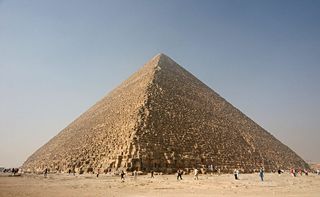
How Much Would It Cost to Build the Great Pyramid Today?

Even with cranes, helicopters, tractors and trucks at our disposal, it would be tough to construct the Great Pyramid of Giza today. Its construction 4,500 years ago is so astounding in some people's eyes that they invoke mystical or even alien involvement. But the current theory of the building of the Great Pyramid — the notion that it was assembled from the inside out, via a spiraling internal ramp — is probably still the best construction plan.
Following that plan, we could replicate the Wonder of the Ancient World for a cool $5 billion.
First, let's look at the blueprint: The pyramid is 756 feet long on each side, 481 feet high, and composed of 2.3 million stones weighing nearly 3 tons each for a total mass of 6.5 million tons. Legend has it that the structure was erected in just 20 years' time, meaning that a block had to have been moved into place about every 5 minutes of each day and night. That pace would have required the (slave) labor of thousands. While traditional theories hold that the pyramid was built via a long external ramp, such a ramp would have had to wind around for more than a mile to be shallow enough to drag stones up, and it would have had a stone volume twice that of the pyramid itself.
A new, more economical theory gaining traction among architects and Egyptologists holds that the bottom third of the pyramid's height wasconstructed by stones dragged up an external ramp. But above that — for the remaining 33 percent or so of the pyramidal volume — the Egyptians worked their way up through the inside of the structure, building around a gently sloping internal ramp and fitting stone blocks into place as they ascended. Furthermore, the workers could have re-used the stones quarried for the external ramp to build the pyramid's upper echelons, so that nothing went to waste. [The Most Monumental Monument Mistakes]
Jean-Pierre Houdin, the French architect who developed the internal ramp theory, has collaborated with a team at Dassault Systems, a 3D graphics firm, to create a virtual model of the construction process. A team of scholars at Laval University in Quebec is now planning an infrared imaging investigation, which could soon reveal the spiraling ramp within the Great Pyramid; if found, it will be the final proof of Houdin's theory. But whether or not the theory bears out, Houdin says an inside-out construction would still be the best way to build the Great Pyramid.
"I am quite sure we could do the same today, and it would be the most economical method," Houdin told Life's Little Mysteries.
There would be two main differences between pyramid-building now and then. First, "Instead of people pulling the sleds that carry the stones up the ramps, you would use something with an engine," he said. Secondly, "for the [topmost] 10 or 15 meters, you would use a small crane."
Sign up for the Live Science daily newsletter now
Get the world’s most fascinating discoveries delivered straight to your inbox.
Just as cranes are lifted onto the tops of skyscrapers today, a helicopter would apposition a crane onto a flat top of the pyramid. Stones and other construction materials dragged up to that level via the internal ramp would then be set in place by the crane. (It wouldn't be feasible to build the entire structure with cranes, Houdin said, because they wouldn't be able to reach far enough to lift materials from the base to the center of the top of the pyramid.) [Why is the Great Pyramid So Sloppy?]
While the pyramid was originally built by 4,000 workers over the course of 20 years using strength, sleds and ropes, building the pyramid today using stone-carrying vehicles, cranes and helicopters would probably take 1,500 to 2,000 workers around five years, and it would cost on the order of $5 billion, Houdin said, based on manpower and cost of constructing the Hoover Dam on the Colorado River during the Great Depression. The dam contains a volume of concrete roughly equal to the stone in the pyramid. By comparison, the 1,776-foot-tall One World Trade Center being constructed in downtown Manhattan will cost an estimated $4 billion.
There are no plans to build a full-scale Great Pyramid, but a campaign for a scaled-down model is underway. The Earth Pyramid Project, based in the United Kingdom, is raising funds to erect a pyramidal structure in an as-yet-undecided location, built of stones quarried all around the world. It will contain a time capsule, to be opened 1,000 years from now. Funded by governments and organizations around the globe, the Earth Pyramid will not only provide a window into contemporary culture for future societies, it will also serve as an opportunity to test Houdin's construction theory of the Great Pyramid of Giza.
Follow Natalie Wolchover on Twitter @nattyover. Follow Life's Little Mysteries on Twitter @llmysteries, then join us on Facebook.
Natalie Wolchover was a staff writer for Live Science from 2010 to 2012 and is currently a senior physics writer and editor for Quanta Magazine. She holds a bachelor's degree in physics from Tufts University and has studied physics at the University of California, Berkeley. Along with the staff of Quanta, Wolchover won the 2022 Pulitzer Prize for explanatory writing for her work on the building of the James Webb Space Telescope. Her work has also appeared in the The Best American Science and Nature Writing and The Best Writing on Mathematics, Nature, The New Yorker and Popular Science. She was the 2016 winner of the Evert Clark/Seth Payne Award, an annual prize for young science journalists, as well as the winner of the 2017 Science Communication Award for the American Institute of Physics.
Most Popular


